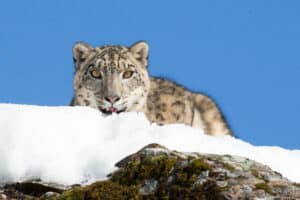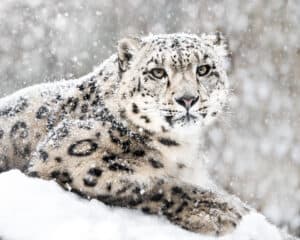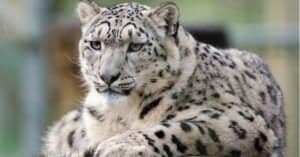Continue reading for our analysis...

Snow leopards have adapted to survive in some of the most challenging environments on the planet. Their enormous black rosettes and thick white-gray coats fit in nicely with Asia’s high, rugged mountains.
Take a look at the video to see if a snow leopard can escape a pack of ravenous wolves!
These cats are regularly alluded to as the “ghost of the mountains” due to their spectacular natural camouflage, which virtually makes them undetectable in their surroundings. The snow leopard can easily climb very steep slopes thanks to its muscular physique.
The snow leopard can jump six times as far as its body length thanks to its rear legs. Long tails let animals move quickly, balance themselves, and shield the snow leopard from the elements while it is resting.
So when someone filmed a lone snow leopard getting cornered by a wolf pack, they were betting on the feline! A wolf’s body is about three to five feet long, while its tail is typically one to two feet long. Males and females normally weigh 70 to 145 pounds and 60 to 100 pounds, respectively. Snow leopards weigh roughly the same as female wolves, which is surprising.
Due to their preference for eating large hoofed mammals like deer, moose, bison, and elk, wolves are carnivores. Additionally, they pursue smaller mammals including hares, rats, and beavers. Adults may consume 20 pounds of beef in one sitting.
Body Language and Hunting Tactics

A snow leopard can jump six times as far as its body length thanks to its rear legs.
©Chris Desborough/Shutterstock.com
Body posture, scent markings, howling, snarling, and wailing are all ways that wolves communicate. Their communication frequently focuses on preserving the pack’s social structure. A wolf may roll over on its back, whine, pull in its tail, lick the mouth of another wolf, or stoop to demonstrate its submissiveness.
One of the less well-known wolf realities is that a pack consists of more than simply the individual wolves that go out to hunt. In reality, they are intricate social organizations with a clear hierarchy, links of allegiance among pack members, and dominant group leaders.
In prime feeding seasons, wolves will occasionally seek smaller game on their own, but they will often band together for safety and to boost their chances of success while pursuing larger or more dangerous species. Members of the pack will frequently build incredibly devoted social relationships with one another and will constantly profit from the pack.
When ready, the stalking wolves will charge the prey animals head-on and frequently make an effort to pick out sick, injured, or young animals to kill. The majority of animals will run away when threatened, while larger creatures like moose or bison may defend their territory and engage in combat.
In this scenario, the wolves will surround and continuously search for points of vulnerability, then strike when they discover a favorable position. Instead of taking the chance of attacking a large animal that is ready to fight, wolves may decide to attempt different prey.
Thank you for reading! Have some feedback for us? Contact the AZ Animals editorial team.






